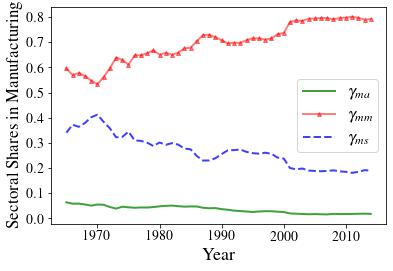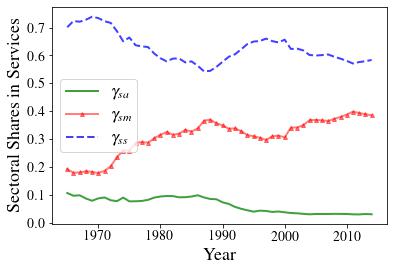Time-Varying Sectoral Linkages and Structural Change
I. Facts on varying input-ouput linkages



FIGURE I: Intermediate input shares in South Korea over time.
II. The share of manufacturing employment and the use of inputs in other sectors.
Figure II illustrates the relationship between manufacturing employment share and the use of manufacturing goods as intermediate inputs in other sectors from 1960 to 2010. The initial increase in both these measures until mid-1980s represents the growing prominence of manufacturing in the economy, largely driven by other sectors' increasing dependence on manufacturing products. However, post-1985, a noticeable decline in these indicators suggests a shift towards a service-oriented economy, and a reduced role of manufacturing. Structural changes, including alterations in production patterns and demand, have influenced these shifts over time.

FIGURE II: Manufacturing Labor Share and Input Shares in South Korea (1965-2014).
III. What we do
We consider a two-country, three-sector Eaton-Kortum trade model, as in Uy et al. (2013). This model integrates non-unitary income and substitution elasticities of demand, as well as sector-specific productivity growth. This unique combination enables the coexistence of both Engel’s law and the Baumol effect within the economy. In each sector, there is a continuum of varieties, and production relies on both labor and intermediate inputs. Trade costs vary across sectors, country-pairs, and over time. These dynamic and time-varying trade costs play a significant role in driving structural changes within the economy. The objective is to quantify how variations in input use intensities across different sectors contribute to changes in the labor share within the manufacturing sector.
The objective is to quantify how variations in input use intensities across different sectors contribute to changes in the labor share within the manufacturing sector.
